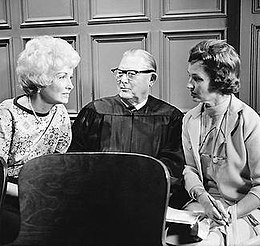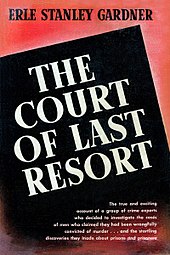Gardner was born in Malden, Massachusetts, the son of Grace Adelma (Waugh) and Charles Walter Gardner.[2][3] Gardner graduated from Palo Alto High School in California in 1909 and enrolled at Valparaiso University School of Law in Indiana. He was suspended after approximately one month when his interest in boxing became a distraction. He returned to California, pursued his legal education on his own, and passed the California State Bar examination in 1911.[4]
Gardner started his legal career by working as a typist at a law firm in California for three years. Once he was admitted to the Bar he started working as a trial lawyer by defending the impoverished, in particular Chinese and Mexican immigrants. This experience led to his founding The Court of Last Resort in the 1940s. The Court of Last Resort, dedicated to helping people who were imprisoned unfairly or couldn't get a fair trial,[5] was the first of several organizations that advocate for the wrongly convicted, which among others include The Innocence Project,[6] Center on Wrongful Convictions at Northwestern Pritzker School of Law[7] and Centurion.[8]
In 1912, Gardner wed Natalie Frances Talbert. They had a daughter, Grace.[9] He opened his first law office in Merced in 1917, but closed it after accepting a position at a sales agency. In 1921, he returned to law as a member of the Ventura firm Sheridan, Orr, Drapeau, and Gardner,[4][10] where he remained until the publication of his first Perry Mason novel in 1933.[11]
Gardner enjoyed litigation and the development of trial strategy but was otherwise bored by legal practice. In his spare time, he began writing for pulp magazines. His first story, The Police in the House, was published in June 1921 in Breezy magazine.[12] He created many series characters for the pulps, including the ingenious Lester Leith, a parody of the "gentleman thief" in the tradition of A. J. Raffles; and Ken Corning, crusading lawyer, crime sleuth, and archetype for his most successful creation, Perry Mason. While the Perry Mason novels seldom delved deeply into characters' lives, the novels were rich in plot detail which was reality-based and drawn from his own experience.[13] In his early years writing for the pulp magazine market, Gardner set himself a quota of 1,200,000 words a year.[14]: 13 Early on, he typed stories himself, using two fingers, but later dictated them to a team of secretaries.[15]
Under the pen name A. A. Fair, Gardner wrote a series of novels about the private detective firm Cool and Lam. In another series, district attorney Doug Selby litigated against attorney Alphonse Baker Carr in an inversion of the Perry Mason scenario. Prosecutor Selby is portrayed as a courageous and imaginative crime solver; his antagonist Carr is a wily shyster whose clients are invariably "as guilty as hell".
Much of the first Perry Mason novel,The Case of the Velvet Claws, published in 1933 is set at the historic Pierpont Inn near Gardner's old law office in Ventura, CA.[11] In 1937, Gardner moved to Temecula, California, where he lived for the rest of his life. With the success of the Mason series, more than 80 novels, Gardner gradually reduced his contributions to the pulp magazines until the medium died in the 1950s. Thereafter, he published a few short stories in the "glossies", such as Collier's, Sports Afield, and Look,[16] but most of his postwar magazine contributions were nonfiction articles on travel, Western history, and forensic science. Gardner's readership was a broad and international one, including the English novelist Evelyn Waugh, who in 1949 called Gardner the best living American writer.[17][18] He also created characters for various radio programs, including Christopher London (1950), starring Glenn Ford, and A Life in Your Hands (1949–1952).[19]
Gardner's character, Perry Mason, was a recurring character in a series of Hollywood films in the 1930s, and then for the radio program Perry Mason, which ran from 1943 to 1955. In 1954, CBS proposed transforming Perry Mason into a TV soap opera. When Gardner opposed the idea, CBS created The Edge of Night, featuring John Larkin—who voiced Mason on the radio show—as a thinly veiled imitation of the Mason character.[19]: 199–201 Perry Mason’s character was inspired by Earl Rogers, a trial attorney who appeared in 77 murder trials but only lost three. He was recognized for the extensive use of demonstratives, e.g., visuals, charts and diagrams, during trial before it became common practice. Rogers is famous for his defense of, and attorney-client disagreement with, Clarence Darrow, a fellow attorney who was charged with attempted jury bribery in 1912.[20]
In 1957, Perry Mason became a long-running CBS-TV courtroom drama series, starring Raymond Burr in the title role. Burr had auditioned for the role of the district attorney Hamilton Burger, but Gardner reportedly declared he was the embodiment of Perry Mason.[21] Gardner made an uncredited appearance as a judge in "The Case of the Final Fade-Out" (1966), the last episode of the series.[22][23]: 24
He had a lifelong fascination with Baja California and wrote a series of nonfiction travel accounts describing his extensive explorations of the peninsula by boat, truck, airplane, and helicopter.
Gardner devoted thousands of hours to "The Court of Last Resort", in collaboration with his many friends in the forensic, legal, and investigative communities. The project sought to review, and when appropriate, reverse miscarriages of justice against criminal defendants who had been convicted because of poor legal representation, abuse, misinterpretation of forensic evidence, or careless or malicious actions of police or prosecutors. The resulting 1952 book earned Gardner his only Edgar Award, in the Best Fact Crime category,[24] and was later made into a TV series, The Court of Last Resort. Wikipedia







No comments:
Post a Comment